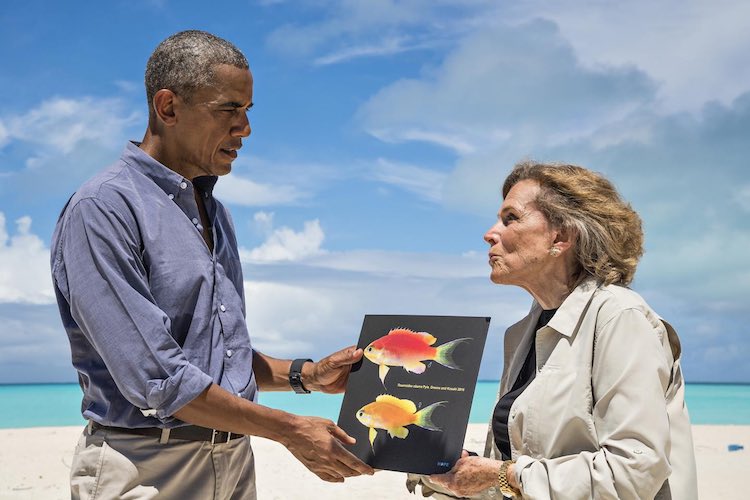As a gesture of appreciation for his administration’s conservation achievements, Hawaiian scientists have named a new species of coral-reef fish after President Barack Obama.
The fish, which now bears the formal scientific name Tosanoides obama, displays a colorful spot reminiscent of the Obama campaign’s famous logo. The species was discovered during a June 2016 NOAA expedition to Papahānaumokuākea Marine National Monument in the remote Northwestern Hawaiian Islands.
GOOD NEWS: Manatee Population Has Rebounded 500 Percent, No Longer Endangered
On August 26 of this year, at the urging of Sen. Brian Schatz (D-Hawaii), and many conservationists and marine scientists, the Obama administration expanded Papahānaumokuākea Marine National Monument to 582,578 square miles, making it the largest permanently protected marine area on Earth.
During the president’s September trip to Midway Atoll within the Monument, deep ocean explorer Dr. Sylvia Earle gave him a photograph of the fish that now bears his name. The exchange will be featured in the National Geographic global broadcast special, “Sea Of Hope” scheduled for January 15, 2017.
RELATED: Bird Thought to Be Extinct Re-emerges in Myanmar
The small pink and yellow fish is a kind of basslet, a group that includes many colorful reef fishes popular in the marine aquarium fish trade. There are two other species in the genus Tosanoides, both from the tropical northwestern Pacific Ocean. Males of the new species have a distinctive spot on the dorsal fin near the tail, which is blue around the edge and red with yellow stripes in the center.
“The new fish is special because it is the only known species of coral-reef fish endemic to the Monument (meaning that the species is found nowhere else on Earth). Our research has documented the highest rate of fish endemism in the world — 100% — living on the deep reefs where we found this new species,” said NOAA scientist Randall Kosaki, chief scientist of the research cruise, and co-author on the study.
MORE: Video Game Chief Pays $15M for Protection of 7,000 North Carolina Acres
However, unlike all the other Hawaiian endemic species, which also occur in the main Hawaiian Islands, this new species is special because it is the only one that is limited to within the Monument itself. “Endemic species are unique contributions to global biodiversity. With the onslaught of climate change, we are at risk of losing some of these undiscovered species before we even know they exist.”
The new fish was first discovered and collected on a dive to 300 feet at Kure Atoll, 1,200 miles northwest of Honolulu. Kure is the northernmost of the Hawaiian Islands, and is the highest latitude coral atoll in the world. Deep coral reefs at depths of 150 to 500 feet, in the so-called “Twilight Zone” (also known as mesophotic coral ecosystems), are among the most poorly explored of all marine ecosystems. Located deeper than divers using conventional scuba gear can safely venture, these reefs represent a new frontier for coral-reef research. Pyle and co-authors Brian Greene and Randall Kosaki pioneered the use of advanced mixed-gas diving systems known as closed-circuit rebreathers for Twilight Zone research, and have been documenting the previously unexplored deep reefs throughout Hawai’i and the broader Pacific for the past three decades.
This is the second new species of fish from Papahānaumokuākea named this year. In August, Pyle and Kosaki published the description of a new species of butterflyfish (Prognathodes basabei) based on specimens collected on deep reefs at Pearl and Hermes Atoll earlier this year. President Obama also has several species from other locales named after him: a trapdoor spider, a speckled freshwater darter (fish), a parasitic hairworm, and an extinct lizard. (Source: Pensoft)
Yes We Can… Share This News – Photo by Brian Skerry, National Geographic




















